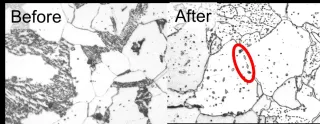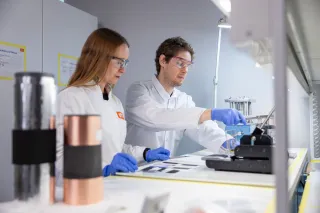Critical components in power plants, such as super heater pipes and main steam lines need to last and function flawlessly until the next scheduled shutdown. If not, the consequences can be costly. Due to high temperatures at power plants, materials used in critical components must endure extremely tough conditions. The lifetime of a component is determined in normal operation by its material microstructural and mechanical stability.
At high temperatures, changes occur in the microstructures of ferrite-pearlite steel, a material often used in power plants. High temperatures cause the dissolution of the pearlite, which leads to the formation of carbides at grain boundaries, weakening the material’s mechanical properties and shortening the lifespan of components. Did you know that these carbide formations can help determine the lifespan of power plant components?
Scientists have long been aware of the problems cause by carbide formation, but how can the life expectancy of a material be predicted, or the problem be avoided altogether? At VTT, we have developed computational models and material libraries for just this purpose. Using these, we can accurately predict the lifespan of materials in relation to their operating conditions and requirements.

Carbide formation studies enable us to determine component life spans
Our material library has thousands of microstructure images of materials that have been exposed in laboratory conditions, and whose mechanical properties we know. Using these, we can evaluate the condition of any material sample taken from the field by comparing its microstructure with an equivalent in our library.
In this way, we can predict carbide formation by means of mathematical models, which take into account the starting point, operating conditions and level of stress to which the material is being exposed. This data enables us to define the remaining lifespan of a component, in other words, measure how much longer it will be able to fulfil its operational requirements. This is very important information when it comes to the uninterrupted and safe running of a power plant, not to mention the huge economic risk that comes with an unscheduled shut down.
Our models can also help reduce carbide formation
These same calculations can also be applied to reduce carbide formation, through operating temperature and pressure adjustments. The type of material selected can also cut down high-temperature damage, for example by replacing 10Mo3 steel with 13CrMo44, which has slightly more chromium. The latter is in the same price range but more resistant to corrosion at high-temperatures.
Of course, there are some cases when the lifespan of components can’t be forecast using only a material’s microstructure. For example, in the case of a sample taken from a pipe where other factors also need to be considered. Pipes often carry hot liquids, which means water chemistry, oxidation of the material and corrosion all need to be taken into account when examining a component’s lifespan.
Power plants generate energy and heat for society and downtime can easily cost hundreds of thousands, if not millions, of Euro. For this reason, operators want to keep unplanned shutdowns to a minimum and perform all necessary (including preventative) maintenance during so-called planned shutdowns. A small examination now can lead to major savings later!
VTT ProperScan® enables you to define the current status of your plant or its single components. Due to extreme conditions, phenomena such as corrosion, erosion or wear may cause failures that can be difficult to predict. ProperScan® helps predict how to react to changes in your operating environment and how risks can be monitored and controlled. With the help of ProperScan® services, you gain information on e.g. how long your plant can be operational with the present parameters and when to perform the needed repairs in the plant.
With ProperScan® you can:
– extend the lifetime of plant components
– have uninterrupted and safe operations
– reduce economic risks at system level



